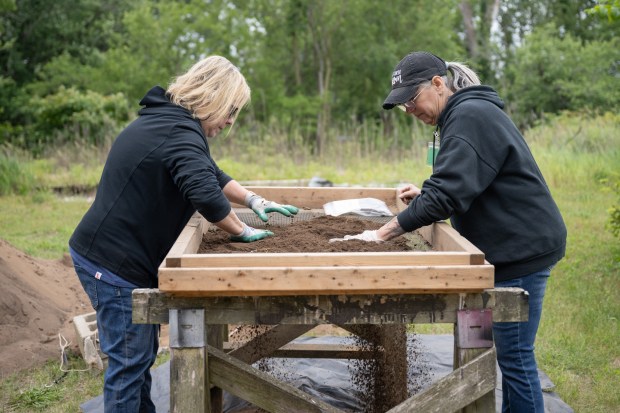In this, the 20th anniversary year of the first public Collier Lodge archaeological dig on the banks of the Kankakee River in Kouts, the finds are still being unearthed. And while the historical nature of their work is significant, the amateur Indiana Joneses find a lot of humor among the artifacts.
“Didn’t we find a lawnmower blade last year? I think we did,” said Crown Point resident Jon Terpstra after Notre Dame senior anthropology and Arabic major Charlotte Cardarella advised him and his digging partner, Mark Smith, of Bettendorf, Iowa, to leave a brick in place next to a thin strip of metal in their two-by-two-meter unit.
“That’s why the blade is there, because it hit the brick,” chimed in Tim Piepenbrink, of the Crete Area Historical Society, watching from outside the string line. The group, comprised of volunteers brought together by the Kankakee Valley Historical Society and Notre Dame Anthropology Professor Mark Schurr, have opened up three units since the dig began last Tuesday.
They’re excavating prehistoric pits used to roast potato-like tubers found in the marsh.
“They would dig these things down about a yard into the soil,” Schurr said.
The variety of items they’ve found in the pits over the last two decades, from prehistoric cord-marked pottery to flints left behind by French soldiers, is what has Terpstra back for his second year of digging.
“This field right here is like a treasure trove of artifacts because it’s just been a natural crossing point in the Grand Kankakee Marsh for thousands of years,” he said.
Bettendorf agreed.
He has experience on other domestic digs in Iowa, Illinois and Virginia, but says the Collier Lodge site is different. “History has been packed into a really small area – current time to 9,000 years ago,” Bettendorf said. “That’s kind of unique. Usually, you might find woodland Indians or a pioneer cabin, but this is all together.”

That might be why the dig has been happening on and off for 20 years. “That’s kind of long,” Schurr admits. “To have such a long-running project is pretty a-typical I would say.” As to how long the digging will continue, Schurr was coy.
He was more concrete on how much he’d like the group to unearth on any given day.
“If we could do 8 inches a day that would be a good day,” he said. “Often if you’re digging in a small hole you can easily go too deep. We only want to go a max of 10 centimeters so we can look at things in layers. If we go too deep, we lose control.”
So far this year a machined iron bar likely from the late 1800s or early 1900s has people speculating.
“It’s more exciting than a beer can,” said St. John resident Dan Durochik, referring to conical-topped vintage beer cans that have been found in years past.

“People have more opinions on this than they do on beer cans,” Schurr agreed.
Because the former great marshland encompasses a much wider area than a few square meters on the banks of the Kankakee River, Kankakee Valley Historical Society President John Hodson has some basic advice for the accidental archaeologist.
“If you’re just digging for a rose bush and you come up with an arrowhead it’s yours,” he said.
“If you come up with a bone that’s different,” he added, explaining that in that scenario, digging should immediately stop until experts can be brought in for a variety of reasons, from cultural respect to potential federal law, to the importance of context to unearthed remains.

This year’s Collier Lodge Dig continues through Thursday, June 20. The dig is closed Fridays for lab work. Dig hours are about 9:15 a.m. to 3 p.m. Monday through Thursday. The public is welcome. Children require guardian supervision.
Shelley Jones is a freelance reporter for the Post-Tribune.



